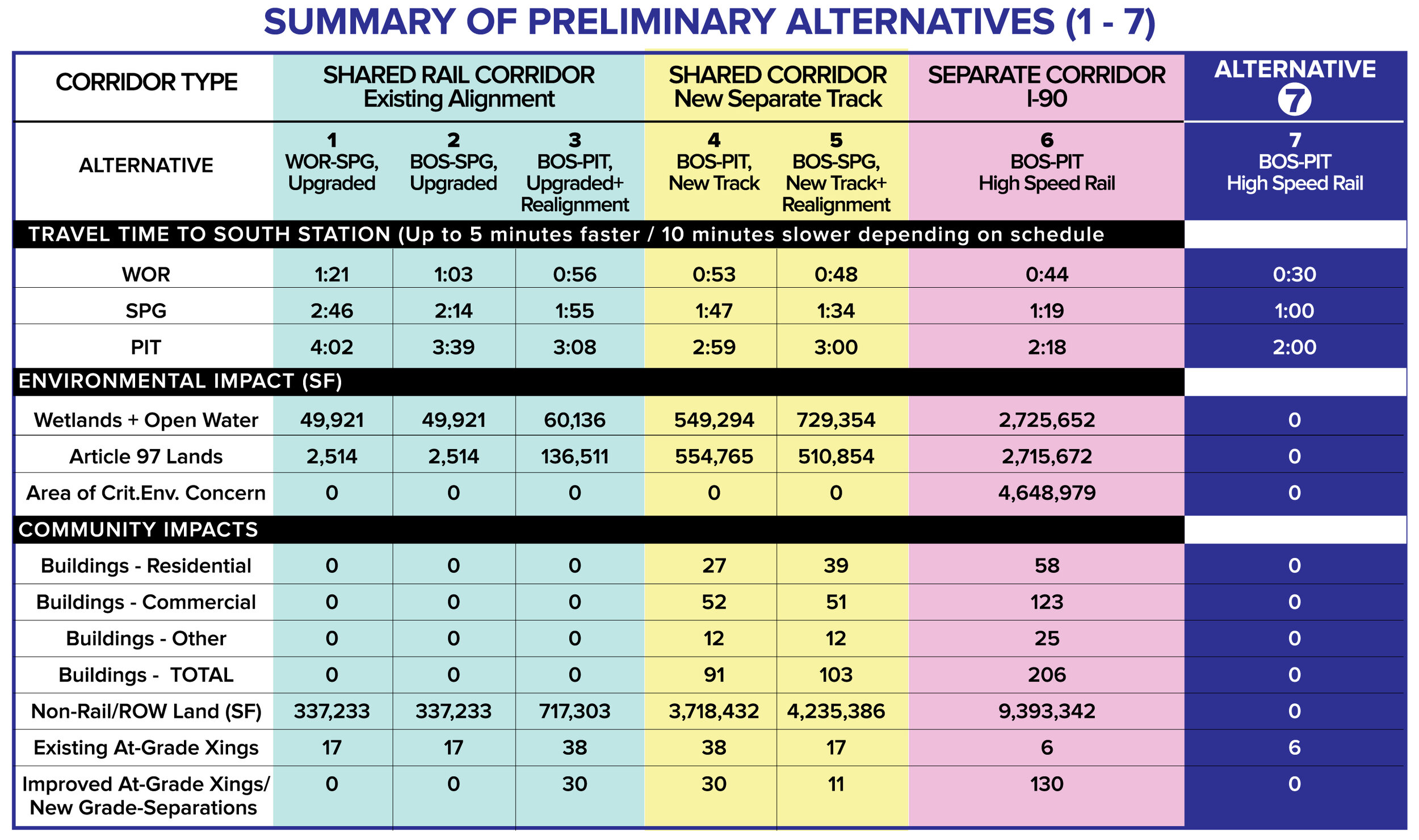
East/West Rail Study:
Alternative 7 is a proposal that will provide true highspeed passenger rail service between Springfield and Boston.
While Boston and its environs have seen tremendous growth and development in the last twenty years, the central and western parts of the state have been largely left behind. Access is the principal reason. The current transportation options between Springfield, Worcester and Boston come down to one option, the Massachusetts Turnpike. Rail from Springfield is nonexistent and Worcester to Boston is too slow to attract any commuters except those that have no choice.
High speed rail would address a myriad of the problems and issues facing the Commonwealth. We stand to lose our best workers, companies, investment and our competitiveness because of commuting times, housing costs and quality of lifestyle.
While Massachusetts has one of the largest public subway and rail systems in the country, it is also one of the oldest. On the other hand, we are national and world leaders in cutting edge technology. The East/West high-speed rail would be the show case on how to tie our cities together to increase and spread economic opportunity
The Massachusetts Department of Transportation (DOT) is performing a study of an improved rail line between Boston and Pittsfield. Of the six alternatives outlined in the East-West Rail Study Advisory Committee Meeting Notes- July 23, 2019 and February 6, 2020 none of them proposes an average speed over 60 miles per hour.
Any East/West Rail proposal must be a sustained high-speed intercity rail line with enough trains to make its use more attractive than the automobile. Alternative 7 would provide such service.
The DOT is now in the process of narrowing down their alternatives from six to three for final study.
Alternative 7 needs to be included in the Department of Transportation’s final three alternatives to be reviewed.
Alternative 7 in a nutshell:
The problem with most of the current DOT proposals are that they use the existing track rights of way which will not support a sustained high-speed train.
Even with substantial upgrading the current rail line between Palmer and Auburn is too meandering and has too much freight traffic to permit modern high-speed rail service.
Likewise, the current rail line between Worcester and Boston has too many stops, grade crossings, freight traffic and commuter rail traffic to permit modern high-speed rail service.
The answer is to bypass these sections of track by constructing a pair of rail tunnels (Trans Mass Tunnels or TMT) one between Boston (West Station) and Worcester (35 miles), and one between Auburn and Palmer (30 miles). While a portion of the existing track rights of way would still be utilized (Worcester to Auburn and Palmer to Pittsfield), half of the line would be constructed in tunnels beneath the Massachusetts Turnpike and Route Nine.

While it seems rather ambitious to construct such lengthy tunnels, the reality is that the cost to benefit ratio is dramatic.
New tunneling methods have brought down the cost of tunneling substantially. There are many long-distance tunnels operating throughout the world with many more under construction or in the planning stage. In our case there are substantial savings in tunneling as there would be little or no land taking costs. Permitting is a fraction of the cost as compared to above ground construction and building the TMTs in conjunction with the North/South Rail project in Boston would produce substantial savings for both projects.
It could eliminate 30,000 to 40,000 cars from the Mass Pike each day.
If combined with the North South rail project, it could be extended to provide a direct rail link to Logan airport for residents of Central and Western Massachusetts and visa versa for the Boston business community.
It would create a secondary Amtrak rail link between Boston and New York City (including Hartford, Montreal and the West). It would provide a direct Amtrak link to New York for central and Western Massachusetts Residents and Businesses.
Alternative 7, how it compares:
Alternative 7 proposes to upgrade existing track between Pittsfield and Palmer and Auburn and Worcester with new track and alignment as set forth in DOT Alternative 4.
Alternative 7 bypasses the other sections of existing track with rail tunnels under the Mass Pike and Route Nine.
Alternative 7:
· Has no buses as part of it’s plan.
· Provides a stop in both Chester and Palmer.
· Provides a new station at Route 495/Route Nine. None of the DOT alternatives provides service to this important exchange.
· Provides the fastest speeds and thus the shortest travel times.
· Has the smallest environmental impact.
· Has the least amount of land and building takings.
· Has the least amount of grade crossings.
· Has the shortest permitting time.
· Utilizes the least amount of CSX rights of way.
· Has the least impact on current freight and passenger rail operations during construction.
· Has the least impact on abutters during construction.
· Has the least impact on abutters during operations.
· Can be constructed in phases allowing for the immediate start of passenger operations.
· It is the only Alternative which would be truly transformative for Massachusetts.
Please e-mail Makaela Niles @ Makaela.Niles@dot.state.ma.us and
Ethan Britland @ Ethan.Britland@dot.state.ma.us at the Department of Transportation and request that Alternative 7 be included as one of the final three options for further study. (copy us @ jfryer@alternative7.net)
The DOT will only include it for further study if they believe that there is enough interest from the public and public officials. Your e-mail will count.






